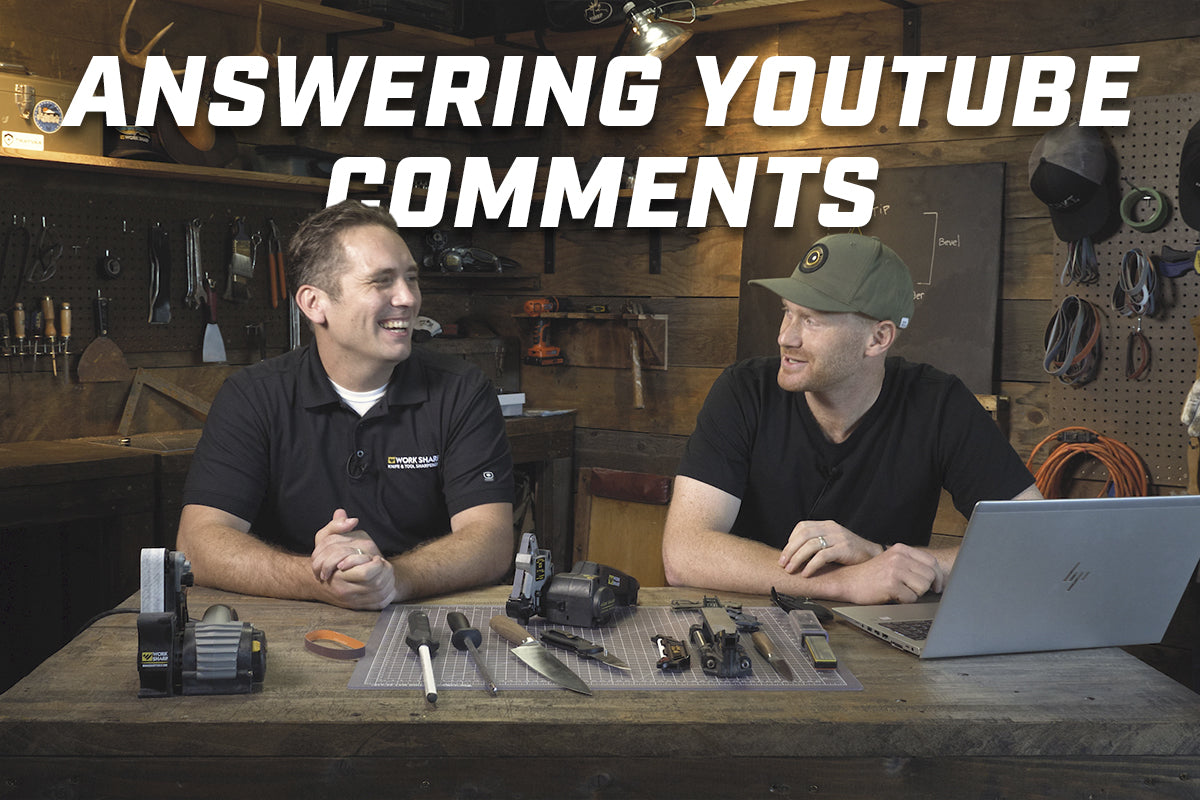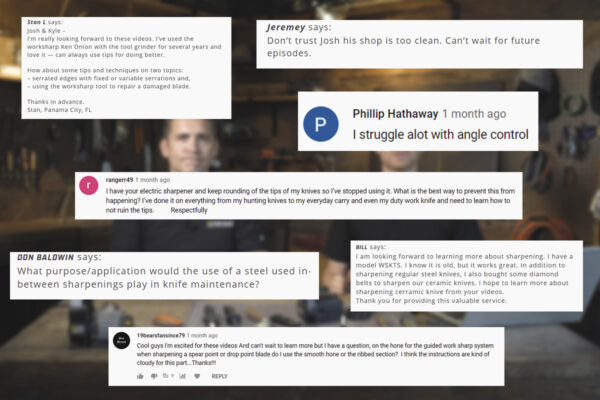Your cart is currently empty!

Answering your Knife Sharpening Questions like How to sharpen serrations?
A lot of questions around knife sharpening have come into our Workshop and this episode we cover some of the common FAQ’s. Today in the shop we are joined by Work Sharp National Account Manager, Ben Holtey, for his expertise on things knife sharpening.
What tips can you share for sharpening knives with fixed or variable serrations?
There are a couple ways to sharpen a knife that has serrations. If using a manual sharpener, an abrasive rod is a great tool to get in-between each serration. Sharpen the serrations on the front side, and knock off the burr from the back side of the blade.
When using a powered sharpener with a belt, run the backside of the blade along the belt to polish the serrated edge back to the original grind.
TIP: Maintaining serrated blades helps keep the teeth of the blade sharp and avoids wear and tear of the serrations.

How do you repair a damaged blade?
Check out our video here https://www.worksharptools.com/how-to-repair-a-chipped-knife/
What purpose does a steel provide between knife sharpening?
After sharpening the edge of a blade on a knife sharpener, using a steel will prolong the sharp edge and extend the time between sharpening by helping push rolled edges back into place.
Work Sharp has a ceramic rod that acts the same as a steel with built-in angle guides to help establish and maintain the angle while using. It eliminates some of the guesswork that comes when using a traditional steel.
How do you sharpen ceramic knives?
When sharpening a ceramic knife, it is important to use a diamond abrasive. Additionally, it is typical not to feel a burr along a ceramic knife and a sharp edge will feel toothier than a traditional steel blade.
TIP: The diamond belts available for the Knife & Tool Sharpener and the Ken Onion Edition Sharpener are intended only for ceramic blades. When sharpening steel knives, it is important to use the standard belts.
How do I stop rounding my tips when using a Work Sharp powered sharpener?
Our belt abrasives are designed to be flexible. This intentionally allows the belt to form to the shape of your blade and create a convex edge. Rounding tips can happen when pulling the blade all the through the sharpener, thus the belt wraps around the tip and rounds it off. To keep this from happening, it is key to stop pulling the knife through the sharpener as the tip of the blade meets the middle of the belt (see video for a up close demo).
TIP: When pulling the knife through a Work Sharp sharpener, keep the knife straight as you pull. Curving the knife upward as you pull will also encourage rounding.
How can I get better control with angles while knife sharpening?
Light pressure helps maintain an angle much easier (do not white knuckle while moving a blade across any abrasive). Many sharpeners come with angle guides to help provide a point of reference. These are great solutions to start out with to help gain muscle memory and expand on the skillset of holding an angle while sharpening.
When sharpening a spear point or drop point blade on the Guided Sharpening System, which abrasive surface should I use?
These blade types can be sharpened using the flat diamond plate and honed using the smooth section of the ceramic.
Knives with a more unique shape, like a recurve, will not work on the flat diamond and will need to be sharpened using the progression of the ceramic rod (ridged edge for sharpening and smooth edge for honing).
That is all the questions we have time for this week. If you did not see the answer you were looking for in this week’s episode, share your question with us on our YouTube page, Facebook, or on this blog post. We are always curious to know what topics you are looking to hear more on.

9 responses to “Answering your Knife Sharpening Questions like How to sharpen serrations?”
what is causing the new belts on my knife and tool WS sharpener tearing after one or two swipes of the knife?
I have a question when it comes to setting the angles when sharpening knives. For example I have a lot of Benchmades and when I called then asking all they would tell me is to use a 15 to 20 degree angle. How do I really know what to use?
Do you have a video showing how to sharpen an Emerson CQC-7?